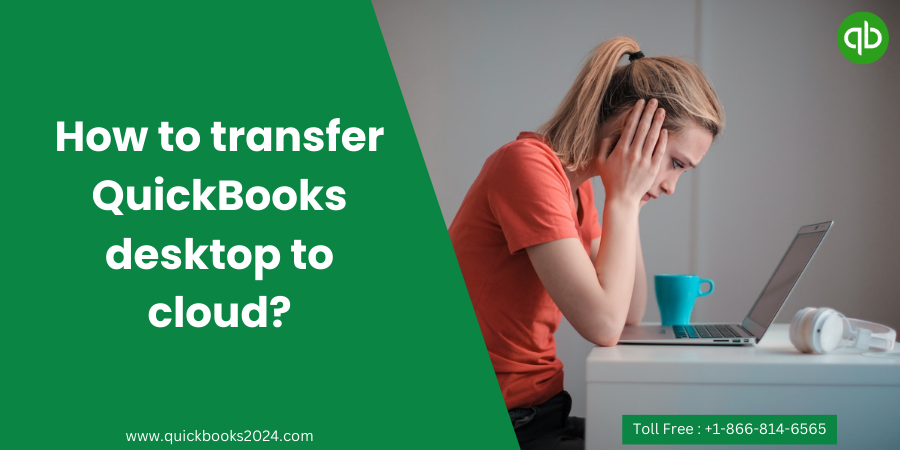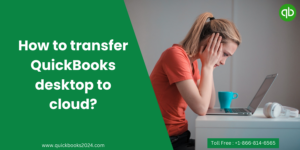
Knowing how to transfer QuickBooks Desktop to the cloud helps you in moving your local QuickBooks data and software to an online cloud hosting service. This process can be beneficial as it allows for more flexible access to your accounting data from anywhere with an internet connection. Let’s understand it briefly.
Steps to transfer QuickBooks Desktop to the cloud:
1. Choose a cloud hosting provide
Research and select a reputable cloud hosting service that supports QuickBooks Desktop. Popular options include QuickBooks Hosting by Intuit, Right Networks, and Ace Cloud Hosting. Compare their features, pricing, and customer reviews to find the best suits your needs.
2. Backup your QuickBooks Desktop data
Before you begin the transfer, create a complete backup of your QuickBooks Desktop data on your computer. This ensures that your financial data is safe and can be restored during migration.
3. Set up an account with the chosen cloud hosting provider
Sign up for a statement with the cloud hosting service you selected. You will need to provide your contact and billing information.
4. Install QuickBooks on the cloud server
The cloud hosting provider will guide you on installing QuickBooks Desktop on their server. They usually offer step-by-step instructions or assistance to get your QuickBooks software up and running in the cloud.
5. Upload your QuickBooks data to the cloud server
After installing QuickBooks on the cloud server, you must upload your company data file (.QBW) to the server. Some hosting providers offer migration services to help you with this step.
6. Verify data integrity
Once your data is uploaded, make sure everything is functioning correctly. Ensure all your financial data, transactions, and reports are accessible and accurate.
7. Test access from various devices
Ensure you can access QuickBooks Desktop from different devices like your computer, laptop, tablet, or smartphone to verify that the cloud setup works smoothly.
8. Update DNS settings (if applicable)
If your domain name is linked to your QuickBooks Desktop, you may need to update your DNS settings to point to the new cloud server.
9. Inform your team and coordinate the transition
If you have multiple users working with QuickBooks, inform them about the growth and any necessary access or login credentials changes.
10. Train your team (if needed)
If your team needs to become more familiar with cloud-based QuickBooks, consider providing basic training to ensure a smooth transition.
11. Monitor and troubleshoot (if necessary)
After the migration, keep an eye on the performance and functionality of QuickBooks on the cloud. If you encounter any issues, contact your cloud hosting provider for support.
Why transfer QuickBooks from desktop to cloud?
Flexibility and mobility are key to staying ahead in today’s fast-paced business environment. That’s where cloud technology comes in. By moving QuickBooks from your desktop to the cloud, you unlock a world of possibilities that can revolutionize how you manage your finances.
First and foremost, accessing QuickBooks on the cloud means freedom from being tied down to a physical office space. You can now work from anywhere – at home, during your morning commute, or while sipping coffee at your favorite café. You no longer have to wait until you’re back on your desktop computer to update invoices or review financial reports.
Another compelling reason is collaboration. With QuickBooks on the cloud, multiple users can access and work on the same files simultaneously. This promotes real-time collaboration and eliminates version control issues when sharing data with colleagues or accountants.
Data security is also greatly enhanced with cloud-based solutions. Cloud providers often employ robust security measures like encryption and regular backups, ensuring your financial data remains safe from loss or unauthorized access.
Tips for a successful transfer
1. Plan Ahead
Before moving to the cloud, planning your transition strategy is crucial. Assess your current infrastructure, determine what data needs to be transferred, and set clear goals and timelines for the migration process.
2. Choose the Right Cloud Provider
Research different QuickBooks cloud hosting providers and select one that aligns with your business requirements. Look for providers that offer reliable uptime, secure data storage, seamless integration with other applications, and excellent customer support.
3. Backup Your Data
Before transferring your QuickBooks desktop to the cloud, backup all your important financial data. This ensures that you won’t lose any critical information even if something goes wrong during the migration process.
4. Train Your Team
Switching from desktop-based software to a cloud-based solution may require some adjustments for your team members. Provide comprehensive training sessions or tutorials on navigating the new system so they can quickly adapt and utilize its full potential.
5. Test before Going Live
It’s always recommended to test the functionality of QuickBooks in the cloud before fully transitioning from desktop mode. Conduct thorough testing by uploading sample files or running trial runs to ensure everything works as expected.
6. Communicate with Stakeholders
Keep all relevant stakeholders informed about the transition process and update them regularly on any changes or disruptions they might expect during this period. Open lines of communication will help minimize confusion and ensure everyone is on board throughout this journey.
7. Monitor Performance & Security
Once you’ve successfully migrated QuickBooks desktop to the cloud, regularly monitor performance metrics such as the speed and responsiveness of applications hosted in the cloud environment.
8. Update Hardware & Software Requirements
Ensure that your hardware meets the minimum requirements specified by the QuickBooks Hosting provider; also update the software required for smooth functioning.
Related Posts:
How to uninstall QuickBooks Cloud RDP from the desktop?
How many companies can you have on QuickBooks desktop with Cloud?
How can I store QuickBooks desktop on the cloud?
Conclusion
In today’s digital age, transferring QuickBooks from desktop to the cloud has become a popular choice for businesses of all sizes. The benefits of accessing your accounting software anytime, anywhere are undeniable. Not only does it increase flexibility and collaboration among team members, but it also ensures data security and reduces IT costs. Now you know how to transfer QuickBooks desktop to cloud.

